#earl of dorset
Text

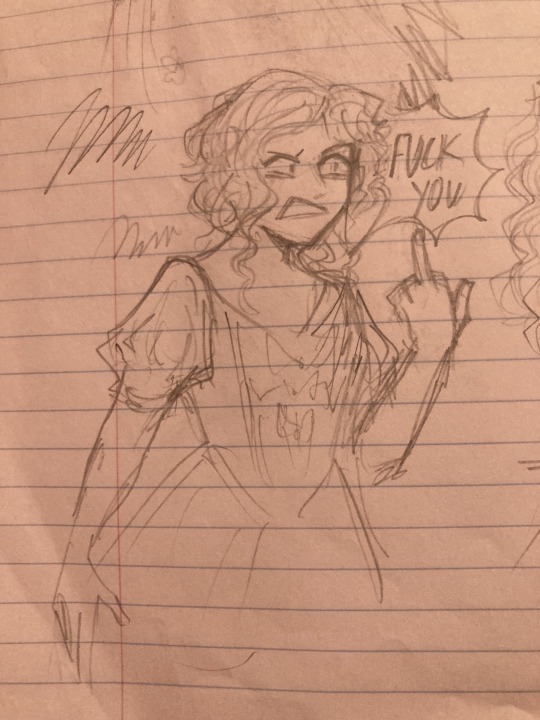
Nelly + 2 Charleses
and a reaction pic :3
#okay no but reading abt nell and sackville in plaidy is fun#JUSR REALIZED SACKVILLES NAME IS CROPPED OUT WHOOPS#should be able to tell apart him and le merry king apart tho#i gave sackville horrendous eyebags yes#or eyeliner <- he would#charles ii of england#charles sackville#earl of dorset#nell gwyn#theres like 936 different ways to spell her full name😭
8 notes
·
View notes
Text
Queens could, of course, be involved in more overtly worldly patronage, often in an intercessory role. A well-documented example is the involvement of the Mercers' Company of London with Elizabeth Woodville in the late 1470s. The queen first interceded for the merchants in 1478, regarding a "fraye" between the king's servants and some London citizens. By December 1479 the company had a much more serious problem; it owed the king an onerous sum for non-payment of its subsidy, and for its alleviation it looked to both Elizabeth and the king's chamberlain (William, Lord Hastings). From the beginning the queen's abilities were recognized as exceptional, not only by the company but by Hastings, who encouraged the merchants to cultivate her rather than himself. In January 1480, after the merchants had given "grete lawde & thanke" to their court connections, including Thomas Grey and "the lord Ryvers", they reported that Hastings had cautioned them "to be more secrete of theyre frendes and that non avaunt be made who that is frendly and laboureth for us Except the quenes good grace oonly, whiche that is, & always hath ben, oure verrey good & gracious lady in the said mater & c.". Evidently dealing with the queen alone would get the company into less political trouble than open lobbying of her relatives -- an indication, perhaps, that Elizabeth was not considered one and the same with "the Woodvilles".
By 8 January 1480, the queen had managed to convince Edward to forgive 500 marks (£333 6s. lOd.) of the fine, and the company decided that she was their most promising option; four days later the fine was further reduced by the same amount.
-Derek Neal, "The Queen's Grace: English Queenship 1464-1503"
#historicwomendaily#elizabeth woodville#I like this because the company evidently panicked and sent appeals to anyone perceived to be prominent and influential at court#including Elizabeth Anthony Dorset Hastings the Earl of Essex etc#But it's clear that at the end of the day Elizabeth was the one with the superior influence and the one who could actually get things done#It's funny when people try to emphasize Hastings' alleged influence when Hastings himself was out there emphasizing Elizabeth's 🤷🏻♀️#And when Edward wrote that he 'most singularly' placed his trust in her above all others in his own will#It certainly seems that the court widely regarded her as the one with the most effective influence#And like Neal points out this demonstrates how she should stop being overlooked and subsumed into larger discussions on her family.#She was the queen consort; her role was singular and distinctive.#Her family weren't known as 'the Woodvilles' by contemporaries either: they were known as 'the queen's kin'
25 notes
·
View notes
Text
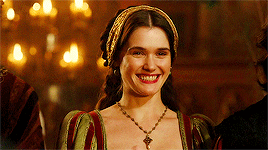



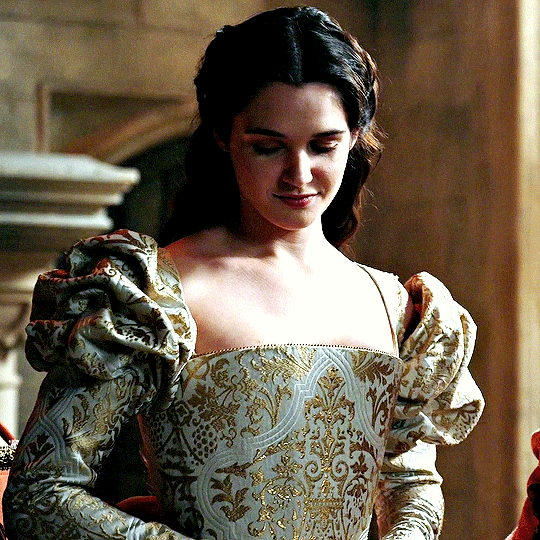
From Princess, to Queen, to Duchess
Mary Tudor (March, c. 1496; London, England - June, 1533; Suffolk, England) was an English princess, the third wife of King Louis XII of France and one of the two sisters of King Henry VIII. Mary was also the grandmother of Lady Jane Grey, who would become titular queen of England for nine days in 1553.
Mary’s father, King Henry VII, betrothed her to Archduke Charles —later Holy Roman Emperor, Charles V — in 1507. In 1514, however, political tribulations caused King Henry VIII to renounce such engagement and arrange a match between his beautiful, charming and yound sister and Louis XII, the sick and french monarch of 52. Since Mary was already in love with Charles Brandon, the first Duke of Suffolk, she made Henry promise that after Louis died she would be allowed to choose her next husband.
The marriage with the french king took place on Octouber of 1514, and Mary performed her role as wife and royal consort with kindness and dedication until he died on January of the following year. Before Henry or the new King of France, Francis I, could use her as a pawn in another political arrangement, Mary secretly wed Suffolk in Paris, probably in late February. Henry VIII was infuriated at the news, but eventually the pair regained the king’s favour, with Suffolk paying him a large sum of money and perhaps with the help and intercession of Cardinal Wolsey.Mary and Charles had four children, two daughters and two sons:
⇒ Henry Brandon (11 March 1516 – 1522);
⇒ Lady Frances Brandon (16 July 1517 – 20 November 1559), married to Henry Grey, 3rd Marquess of Dorset, and mother to Lady Jane Grey;
⇒ Lady Eleanor Brandon (1519 – 27 September 1547), married to Henry Clifford, 2nd Earl of Cumberland;
⇒ Henry Brandon, 1st Earl of Lincoln (c. 1523 – March 1534).
Mary had enjoyed unprecedented freedom during her teenage years at her brother's court. Just fourteen when her father, Henry VII died, she spent the next five years almost completely unchaperoned, encouraged to participate in every event, celebration and feast, each planned to display the opulence of the english royal family. She shared Henry's exuberance for spectacle and, for some time, was one of the central ladies of the court, admired and sociable. Like him, she loved dancing, masques, and parties; they were also very close, with the princess being the apple of the king's eye. It's rumored that Henry's famous warship, the Mary Rose, was named after both his favorite sister and his only daughter with Catherine of Aragon.
Upon her arrival in France, Mary was proclamed, by the Venetian Ambassador, to be "handsome and well favoured, grey-eyed; slight, rather than defective from corpulence, and conducts herself with so much grace, and has such good manners, that for her age of 18 years—and she does not look more—she is a paradise." She was particularly admired by her contemporaries for her long red hair, which she had inherited from the Plantagenet lineage through her mother, Elizabeth of York, who had also been an celebrated beauty.
After her second marriage, the Duchess of Suffolk lived a quiet life in the country, retired from court, although she had been know to have attended the famous Field of the Cloth of Gold at Guines, near Calais, in 1520. Often referred to as the French Queen, she was known to dislike Anne Boleyn and in defiance of her brother was to prove a firm supporter of her sister-in-law, Catherine of Aragon, in the matter of Henry VIII's annulment of his marriage to his first wife.
Mary visited London for the last time to celebrate the wedding of her eldest daughter, Lady Frances Brandon, to Henry Grey, Marquess of Dorset, in 1533. After suffering failing health for some years, Mary Tudor died on 25 June 1533 at the age of thirty-eight at Westhorpe Hall, Westhorpe, Suffolk, possibly of cancer. Henry VIII had requiem masses sung at Westminster Abbey for the repose of her soul and she was given a magnificent funeral, which her husband did not attend. Her body was interred at the Abbey of Bury St Edmunds. The Duke of Suffolk quickly remarried again, in that same year, to his fourteen-year-old ward, Katherine Willoughby (1519–1580), suo jure Baroness Willoughby de Eresby. Katherine had been betrothed to his eldest surviving son, Henry, Earl of Lincoln, but the boy was too young to marry, and Charles, to eager to add the heiress fourtune to his own.
#tudor dynasty#tudor queens#tudor history#tudor era#tudorqueens#the tudors#mary tudor#henry viii#elizabeth of york#charles brandon#tudor england#tudor period#tudor women#english royalty#house of tudor#medieval england#english history
33 notes
·
View notes
Text


By Connor McGovern
16 October 2023
We’ve a lot to thank the trees for. Other than their vital role in the ecosystem, they’ve played an important part in mythology, agriculture, industry, and medicine since humans first walked the Earth.
Remarkably, a good number of the UK's most ancient trees — most of them yews and oaks — still stand today as living, breathing witnesses to centuries of British history.
We take a look at some of the UK’s most fabled trees — and the intriguing stories that surround them.
1. Ankerwycke Yew, Berkshire

Yews are guardians of churchyards throughout Britain. Many represent the oldest and most storied tree specimens.
Few are more spectacular than the Ankerwycke Yew, in the village of Wraysbury, near Staines-upon-Thames.
Measuring 26ft in diameter, it’s a botanical behemoth that’s believed to be around 2,500 years old, making it one of the oldest trees in Britain.
It long outlived the now-ruined St Mary’s Priory, a Benedictine nunnery whose grounds it stood in, and some even believe it to be the true site of the signing of Magna Carta in 1215, rather than Runnymede on the other side of the river.
Its intrigue doesn’t end there — it’s also alleged to stand on the spot where Henry VIII wooed a young Anne Boleyn. If only trees could talk.
2. Isaac Newton’s apple tree, Lincolnshire

Numerous trees are cited as being the very one that inspired the young physicist to investigate the theory of gravity.
But the apple tree in the grounds of Woolsthorpe Manor, near Grantham, has arguably the greatest right to this claim, with a scion planted (and still growing) at Trinity College Cambridge, where Newton once studied.
While the apple story is probably the stuff of scientific myth, it’s almost certain that Newton would’ve been familiar with the tree — which today is at least 350 years old — as it’s the area in which he was born and raised.
The county is also home to another of the country’s stalwarts: the Bowthorpe Oak, reputedly the UK’s girthiest oak, with a hollowed-out trunk so wide that it’s said to have hosted the Earl of Bowthorpe’s parties.
3. The Tolpuddle Martyrs’ Tree, Dorset

Beneath the boughs of a 350-year-old sycamore in the village of Tolpuddle, a small group of agricultural workers gathered in 1833 to lament their poor working conditions and paltry wages — only to be arrested, tried, and sentenced to penal transportation in Australia for seven years.
The six men became known as the Tolpuddle Martyrs, and after much public outcry, they were pardoned and returned to England.
Their cause was a key step in the workers’ rights and unionist movements. It is remembered in the annual Tolpuddle Martyrs’ Festival; a memorial plaque sits beside this great tree.
4. Fortingall Yew, Perthshire

Widely believed to be one of the oldest living trees in the UK (and indeed in Europe), the Fortingall Yew spills over its walled enclosure in a village churchyard like a great shower of dark green needles.
Some experts estimate the tree to be the ripe old age of 3,000, which would make it date as far back as the Bronze Age — some 1,000 years before the Romans had even come up with the name ‘Caledonia’ for Scotland.
The sheer age of the tree means that over time, the trunk has split that it now resembles several smaller yews, rather than one sole, mighty plant.
The future of the Fortingall Yew, however, is precarious, with souvenir-seekers stealing needles and branches, and so compromising its health.
Ongoing conservation efforts that preserve the tree’s DNA by planting saplings in other Scottish churchyards will be key to maintaining its history.
5. Spanish chestnut trees, Herefordshire

Of all the ancient trees at Croft Castle, near Leominster (including the 1,000-year-old Quarry Oak), most noteworthy are perhaps the huge Spanish chestnuts.
Planted in one grand avenue, their origins are believed to hark back to the battle with the Spanish Armada in 1588, when chestnuts were salvaged from the wreckages and planted here at Croft.
In fact, the planting arrangement is said to represent a flotilla when viewed from above.
But it’s at ground level that the trees truly amaze, as they’re almost fantasy-like in their size and contortion.
Take time to admire the gnarled, grotesque trunks and the twisted branches reaching towards the sky.
6. The Chained Oak, Staffordshire

This old oak in scenic Dimmingsdale is now bound in rusty chains.
Local legend has it that in the early 1800s, the Earl of Shrewsbury was accosted by a beggar as he was passing by.
He snubbed the old woman, and in retaliation, she placed a curse on his family that held that every time a branch fell from the oak tree a member of the Earl’s family would die.
That night during a storm, one of the branches fell from the tree and — lo and behold — a relative of the Earl died.
Seized by paranoia, he chained up all the branches to prevent any more falling from the oak.
Even today, as you approach the tree through the thick woodland, there’s a mysterious air to this gnarled old giant.
Just moments away at Alton Towers, the legend is the inspiration for Hex — a psychological hair-raiser of a ride set within the Alton Towers building itself.
#ancient trees#trees#yews#oaks#ecosystem#United Kingdom#British woodlands#fabled trees#Ankerwycke Yew#oldest trees#Henry VIII#Anne Boleyn#Isaac Newton#apple tree#Woolsthorpe Manor#Bowthorpe Oak#Earl of Bowthorpe#Tolpuddle Martyrs’ Tree#Tolpuddle#Tolpuddle Martyrs#Tolpuddle Martyrs’ Festival#Fortingall Yew#Spanish chestnut trees#Croft Castle#Spanish Armada#The Chained Oak#Earl of Shrewsbury#Alton Towers#Hex
21 notes
·
View notes
Note
Did Elizabeth of York, like her mother, arrange marriage and position for her relatives?
Yes, she arranged her sisters' marriages to the heirs of the Earl of Devon and the Earl of Surrey. Whether it was her own original idea or Henry VII's, she provided the necessary arrangements for those marriages to take place, which indicates she was involved in all the essential aspects of it. Besides marriages, which she was involved in general as queen/court hostess, Elizabeth seems to have supported her Dorset nephew (Thomas Grey's eldest son), her Stafford cousins (the children of her aunt Katherine Woodville, one of whom was her lady-in-waiting) and gave a position in her household to her illegitimate brother, Arthur Plantagenet. She also paid for the diet and up-keeping of her Courtenay nephews, the sons of her sister Katherine, who was also one of her ladies.
16 notes
·
View notes
Text
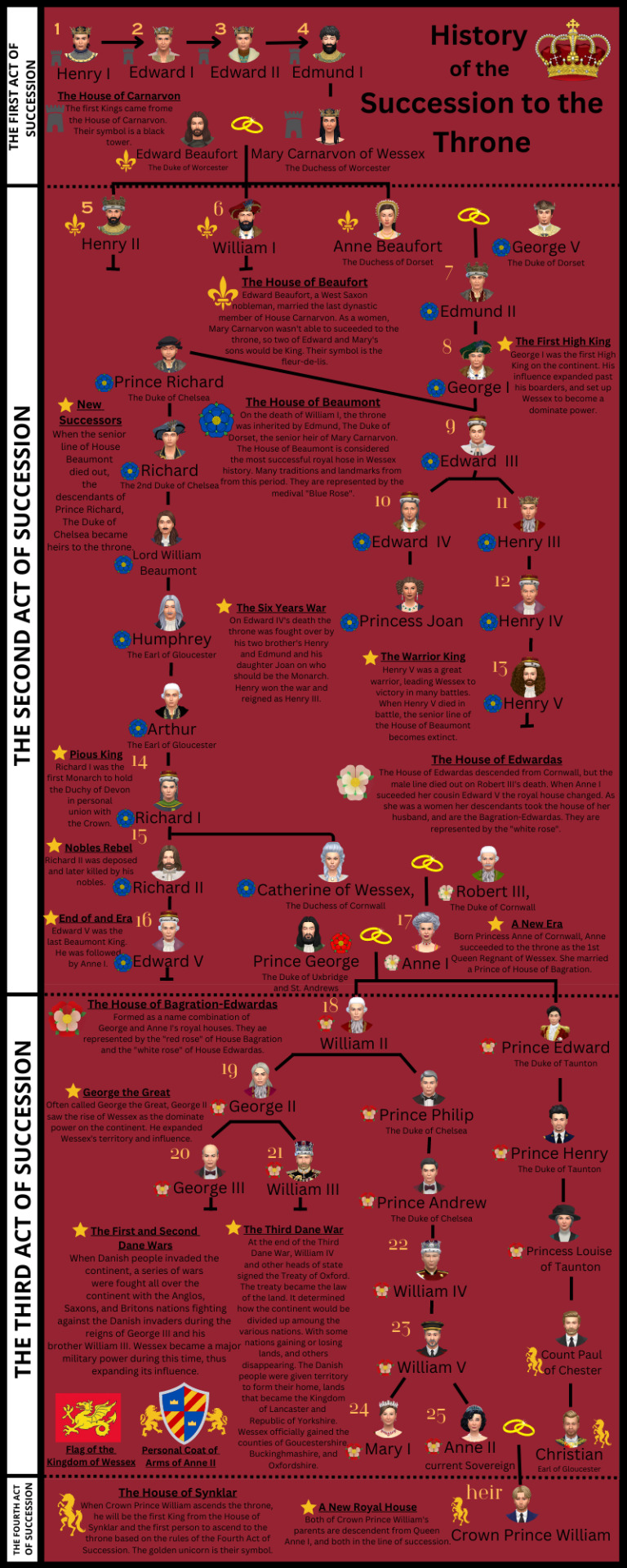
The History of the Succession to the Crown shows the historical succession to the throne of Wessex starting with the 1st monarch to rule from the throne, King Henry I of Wessex, at the top of the chart leading to the current sovereign Queen Anne II of Wessex at “25″ at the bottom.
The symbol/flower next to an individual is which royal house they belong to. There is also a brief description about each house that has ruled Wessex.
Note this chart only shows how each monarch is related to each other and their descent from Henry I of Wessex, not necessarily an entire family tree or the current line of succession.
The First Act of Succession
The First Act of Succession was established when Henry Carnarvon became the first King of a sovereign Wessex after the fall of the Saxon Empire. HE declared that the throne will pass through his male line, and it successfully passed from father to son until his great-grandson King Edmund I failed to produce a living male heir. When King Edmund I realized that there wouldn’t be any male heirs left, he signed the Enfield Declaration which declared the throne would pass the heirs daughter, Princess Mary Carnarvon of Wessex.
The Second Act of Succession
When Mary Carnarvon gave birth to her son, the future King Henry II of Wessex, The Second Act of Succession was officially passed, declaring that all possible claimants to the throne must descend from Princess Mary. Mary and her husband Edward Beaufort, The Duke of Worcester would go on to have five children, but only her youngest daughter Anne who married The Duke of Dorset would have any children to ascend to the throne.
The throne then passed to Anne’s son King Edmund II and passed neatly from father to son, until the death of Edward IV of Wessex. Edward IV has no male children, but he did have a daughter. Some nobles thought that Princess Joan (Edward IV daughter) was the rightful successor, while others thought that Edward IV’s brother Prince Henry, The Duke of Worcester was the more suitable heir.
Those who supported Princess Joan of Wessex argued that the Second Act of Succession referred to “heirs general” and as the senior heir of Princess Mary Carnarvon, and it didn’t matter that she was female. Those for Prince Henry, The Duke of Worcester argued that the Second Act of Succession only referred to heirs male and would only allow for a female succession if the male line of Princess Mary Carnarvon goes extinct. Henry’s supporters won and the throne then passed to Edward IV’s brother, who reigned as King Henry III of Wessex.
It wasn’t until Princess Anne of Cornwall ascended the throne as Queen Anne I of Wessex that Wessex got its first female consort.
The Third Act of Succession
On her accession, Queen Anne I decided to limit the possible heirs to the throne to only her descendants, thus ending any claims of other West-Saxon nobleman who descended from House of Beaumont, and wished to challenge her for the throne. All subsequent monarchs under the Third Act, and later Fourth Act of Succession, must descend from Queen Anne I and her husband Prince George Bagration to be eligible to the throne.
The Fourth Act of Succession
The Fourth Act of Succession is the current Act governing the succession to the throne. It has three basic rules. 1) an individual must be a descendant of Anne I through one of her five legitimate children, 2) members of the occult are banned from inheriting the throne, 3) and the line of succession follows male preference primogeniture.
Succession to the Crown Chart | Princess Royal Chart | Counsellors of the State | The Earl of Gloucester |
25 notes
·
View notes
Text
THIS DAY IN GAY HISTORY
based on: The White Crane Institute's 'Gay Wisdom', Gay Birthdays, Gay For Today, Famous GLBT, glbt-Gay Encylopedia, Today in Gay History, Wikipedia, and more …


1871 – Stephen Crane (d.1900) was an American author. Prolific throughout his short life, he wrote notable works in the Realist tradition as well as early examples of American Naturalism and Impressionism. He is recognized by modern critics as one of the most innovative writers of his generation.
The eighth surviving child of Methodist Protestant parents, Crane began writing at the age of four and had published several articles by the age of 16. Having little interest in university studies, he left school in 1891 to work as a reporter and writer. Crane's first novel was the 1893 Bowery tale Maggie: A Girl of the Streets, generally considered by critics to be the first work of American literary Naturalism. He won international acclaim in 1895 for his Civil War novel The Red Badge of Courage, which he wrote without any battle experience.
In 1896, Crane endured a highly publicized scandal after appearing as a witness in the trial of a suspected prostitute, an acquaintance named Dora Clark. Late that year he accepted an offer to travel to Cuba as a war correspondent. As he waited in Jacksonville, Florida, for passage, he met Cora Taylor, the madam of a brothel, with whom he began a lasting relationship. En route to Cuba, Crane's ship sank off the coast of Florida, leaving him and others adrift for several days in a dinghy. Crane described the ordeal in "The Open Boat". During the final years of his life, he covered conflicts in Greece and lived in England with Cora, where he befriended writers such as Joseph Conrad and H. G. Wells. Plagued by financial difficulties and ill health, Crane died of tuberculosis in a Black Forest sanatorium at the age of 28.
Obsessed with urban street life, Crane left behind an unpublished novel, Flowers of Asphalt, a realistic portrayal of a Gay male prostitute at the turn of the century. No one knows what became of the manuscript or who destroyed it. The reason why it disappeared is much more certain. The trial of Oscar Wilde, only five years before Crane's untimely death, drove the subject underground for more than a generation.
A 1951 film by the same name is seen as an allegory for a young Gay man's coming out, with the handsome (and usually shirtless) son getting ready to leave the house, despite the disapproving gaze of his mother and father. The film's title is taken from the name of a legendary lost manuscript by Crane, which dealt with the then-taboo subject of boy prostitution.
In 2007 Edmund White published the novel Hotel de Dream, based on the 40-page novella fragment about a boy prostitute as recalled in the memoirs of a Crane friend, James Gibbons Huneker.


1896 – Captain Napier Sturt, 3rd Baron Alington was a British peer, the son of Humphrey Sturt, 2nd Baron Alington.
He was born in November 1896 in St. Marylebone district of London. He succeeded to the Barony on 30 July 1919 on the death of his father. He owned the Crichel House estate in Dorset.
He married Lady Mary Sibell Ashley-Cooper, daughter of Anthony Ashley-Cooper, 9th Earl of Shaftesbury, on 27 November 1928. They had one child: Hon. Mary Anna Sibell Elizabeth Sturt who later fought the Government and won, leading to the resignation of a Minister, in the Crichel Down Affair.
Alington may well be most notable for having dated Tallulah Bankhead in the 1920s. Alington was described as "well cultivated, bisexual, with sensuous, meaty lips, a distant, antic charm, a history of mysterious disappearances, and a streak of cruelty." His bisexuality was well known. He was a friend of the Polish composer Karol Szymanowski who dedicated his highly sensuous Songs of an infatuated Muezzin Op.42 to the handsome young Englishman, on their publication in 1922.
He had no male heir upon his death, so the title became extinct. The Crichel estate passed to his 11-year-old daughter Mary, who later married Commander (George) Toby Marten.
In the First World War, he was a Captain in the Royal Air Force. In the Second World War, he was commissioned on 2 July 1940 as an officer of the Royal Air Force Volunteer Reserve in the Administrative and Special Duties Branch and was posted to Cairo, possibly serving as a staff officer at HQ Middle East. He died on 16 September 1940 aged 43 in Cairo on active service of a short illness after pneumonia, and is buried in the New British Protestant Cemetery, Cairo, Egypt.


1937 – Dr. Tom Waddell (d.1987) was the gay American sportsman who founded the international sporting event called the Gay Games, which was named such after the United States Olympic Committee (USOC) sued Dr. Waddell for using the word "Olympic" in the original name "Gay Olympics". The Gay Games are held every four years. The first was in San Francisco in 1982.
Waddell was born Thomas Flubacher on November 1, 1937 in Paterson, New Jersey to a Catholic family. Aware of his homosexual feelings in high school, he excelled in athletics as a means to compensate for them. His parents separated while he was in his teens, and at the age of fifteen he went to live with Gene and Hazel Waddell, for whom he did chores; they adopted him six years later. The Waddells were former vaudeville acrobats and encouraged Tom to take up gymnastics.
In the summer of 1959, he worked at a children's camp in western Massachusetts, where he met his first lover, socialist Enge Menaker, then a 63-year-old man. The men remained close for the rest of Menaker's life, which ended in 1985 when he was ninety years old.
Tom was a football player and gymnast when he was in college at Springfield College, Massachusetts. He served as a military doctor afterward. He represented USA in decathlon at the 1968 Summer Olympics, in which he placed sixth.
In his medical career, he received his MD from Stanford University Medical School. During his life, Waddell had done research on viruses, as well as served the Saudi Royal family. This was followed by moving back to San Francisco where he established his private practice on 18th Street in the Castro neighborhood. He later was employed at a city clinic in the Civic Center area of San Francisco which to this day carries his name.
Waddell happened to attend a Bay Area gay bowling competition, which inspired him to consider organizing a gay sports event modeled on the Olympics. He took up the cause of the "Gay Olympics" by traveling across the country to drum up support. The first Gay Olympics was to take place in San Francisco in 1982 in the form of a sports competition and arts festival, but the U.S. Olympic Committee (U.S.O.C.) sued Waddell's organization over its use of the word "Olympic." Despite the fact that the U.S.O.C. had not previously protested when other groups had used the name, they alleged that allowing a "Gay Olympics" would injure them. They succeeded in securing an injunction just nineteen days before the first games were to begin. Nevertheless, the games, now re-christened the Gay Games, went forward and were a great success, perhaps because they emphasized sportsmanship, personal achievement, and inclusiveness to a far greater degree than the Olympics.
Waddell had a daughter in 1983, Jessica Waddell Lewinstein, with lesbian activist Sara Lewinstein, whom he had met while founding The Games. He died from AIDS in 1987. His battle against HIV/AIDS is one of the subjects of the award-winning documentary Common Threads: Stories from the Quilt.
Waddell wrote an autobiography titled Gay Olympian with sports writer Dick Schaap.


1960 – Tim Cook is an entrepreneur and the CEO of Apple, one of the world's most valuable companies. In 2011, Steve Jobs handpicked Cook as his successor.
Cook was born in Robertsdale, Alabama.
Before joining Apple, Cook managed manufacturing and distribution as director of North American fulfillment for IBM. He also served as chief operating officer at Intelligent Electronics and as as vice president of corporate materials at the Compaq Computer Corporation.
In 1997, Apple reported a loss of a billion dollars and was expected to declare bankruptcy. In 1998, Steve Jobs convinced Cook to accept the position of chief operating officer, despite Cook's reservations. Within a year, Apple reported a profit.
In 2011, Cook became Apple's CEO and a member of the board of directors. He is one of the highest-paid CEOs. He ranked No. 1 on Out magazine's "Power 50" list of the most influential LGBT people in the United States. Forbes magazine named him one of the "World's Most Powerful People."
Cook has kept his personal life private, but has appeared at the top of Out Magazines Power 50 List for 3 years in a row. The closest he had come to publicly acknowledging his homosexuality was in a 2014 speech:
"Since these early days, I have seen and have experienced many types of discrimination and all of them were rooted in the fear of people that were different than the majority."
But on October 30th 2014, two days before his 54th birthday, Cook announced in a interview with Bloomberg Businessweek:
"While I have never denied my sexuality, I haven’t publicly acknowledged it either, until now. So let me be clear: I’m proud to be gay, and I consider being gay among the greatest gifts God has given me."
He also challenged his home state of Alabama to ensure the rights of gay and transgender people.


1971 – The Body Politic begins publishing. The Body Politic was a Canadian monthly magazine, which was published from 1971 to 1987. It was one of Canada's first significant gay publications, and played a prominent role in the development of the LGBT community in Canada.
The magazine was first published on November 1, 1971 by an informal collective, operating out of the home of Glad Day Bookshop owner Jearld Moldenhauer. The collective was incorporated as Pink Triangle Press in 1975.
Writers associated with the magazine included Gerald Hannon, Stan Persky, John Greyson, David Rayside, Sue Golding, Richard Summerbell and Gary Kinsman.
The Body Politic was twice charged with publishing obscene material, in 1977 for Hannon's article "Men Loving Boys Loving Men", and in 1982 for "Lust with a Very Proper Stranger", an article on fisting. The magazine was acquitted in both trials. Materials seized by police in the Hannon trial were not returned to the magazine until 1985.
The magazine ceased publication in 1987, following PTP's launch of the tabloid Xtra! in 1984. In 2008, it was ranked as the 17th most influential magazine in Canadian publishing history by Masthead, the trade magazine of the Canadian magazine publishing industry.
The magazine also created the Canadian Lesbian and Gay Archives in 1973.


1981 – Pierre Fitch, né Viverais, born in Cornwall, Ontario, is a Canadian gay pornography actor, formerly exclusive to Falcon Studios. Although Christian name is Pierre, he admitted that he loved the fashion line Abercrombie & Fitch and so took the surname. He is also an entrepreneur, who now works for himself as an actor and producer of video productions. He is currently performing as a DJ, presenting his own mixes through a number of night clubs in Canada, The United States and Latin America.
His online presence includes his private membership site that includes his almost daily updated blog. He has numerous fan-sites such as the 2008 launched Pierre Fitch Galleries.
Fitch was nominated for the 2006 Best Actor GayVN Award and, with Tom Judson (credited as Gus Mattox), for Best Sex Scene (Duo). He did not win either award, being beaten twice by Johnny Hazzard. Fitch has tattoos all over his body including his neck, chest, stomach, arms and legs.
Fitch is considered "versatile," though more often than not he is seen as the "bottom" (receiver) in scenes featuring anal intercourse. Fitch started off in the industry as a "twink" (younger looking boy), but has now fully grown into a more jock look.
He was previously in a relationship with Ralph Woods. They were reputedly married. In the fall of 2008, Fitch revealed that his marriage to Ralph Woods was never official or legal, but it was a marketing strategy.


2008 – Pin-Ups, by Maurice Vellekoop, a coffee table book of gay erotic cartoon art, is first published.

Maurice Vellekoop (born 1964) is a Canadian artist and illustrator. His work has appeared in publications such as Drawn & Quarterly, Time, GQ, Vogue, Cosmopolitan and Wallpaper, as well as in the books ABC Book: A Homoerotic Primer, Sex Tips from a Dominatrix, Mensroom Reader and Vellevision.
Vellekoop attended the Ontario College of Art and Design from 1982 to 1986. He is openly gay.

His autobiographical I’m So Glad We Had This Time Together is a comic and compassionate late-bloomer’s coming-of-age story that deals with his fraught relationship with his staunchly Calvinist Dutch immigrant parents.


15 notes
·
View notes
Note
Maybe you've been asked this before but just how big do you think book/show My Cottage is/will be? Obviously it's not 'small' like Sophie pictures when Ben mentions a cottage but I'm curious how big do we think it actually is.
I mean Benedict does say “you should have seen his other residence” suggests that My Cottage is more “ironic” than factual.
To me My Cottage is a Country Estate, not as grand as Aubrey Hall
I imagine something like this:
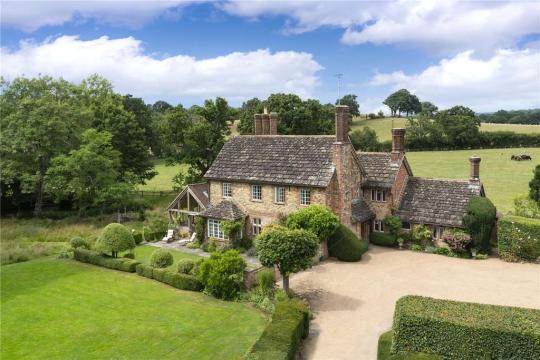
(This is Champions Farm in West Sussex if anyone is interested)
Or like this

(This is in Glanvilles Wootton, Dorset)
Hence why Sophie’s like 👀👀
I also have a little head canon, that this used to belong to the Earl of Penwood but he ought it off the NEW Earl because he had no need for it…
But it’s big enough for all the Bridgerton’s to come but not once everyone has kids…
It’s got enough bedrooms for the siblings and their four kids plus a nursery and a library and his studio…
#my cottage#bridgerton#ask ash#sophie beckett#benedict bridgerton#benophie#benedict x sophie#an offer from a gentleman
47 notes
·
View notes
Text
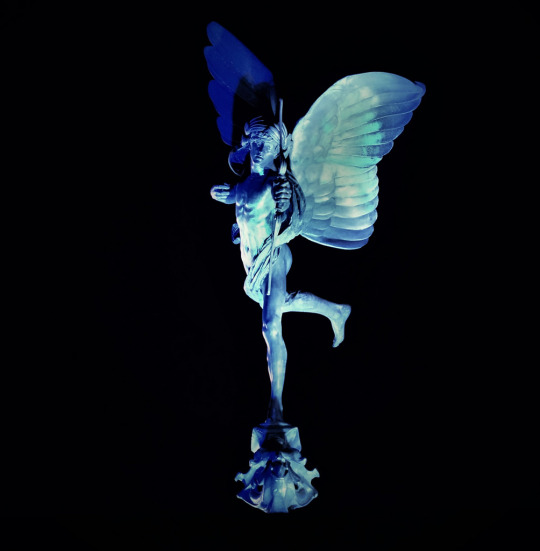

Anteros was unveiled by the Duke of Westminster in Piccadilly Circus, London, on June 29, 1893, as a memorial to Lord Shaftesbury (Westminster and Shaftesbury being fellow Old Harrovians).
The first sculpture in the world to be cast in aluminium, Anteros is mounted on a bronze fountain. It symbolises the selfless philanthropic love of the Earl of Shaftesbury for the poor and is officially titled 'The Angel of Christian Charity'; though it's often popularly mistaken for 'Eros'.
Lord Shaftesbury died on October 1, 1885 – the route to Westminster Abbey where his funeral service was held, thronged with poor people, costermongers, flower-girls, boot-blacks, crossing-sweepers, factory-hands and similar workers who waited for hours to see Shaftesbury's coffin as it passed by.
Due to his constant advocacy for the better treatment of the working classes, Shaftesbury became known as the 'Poor Man's Earl'.
Lord Shaftesbury rests at the Parish Church of Wimborne St Giles, Dorset
42 notes
·
View notes
Text
In light of all the horrid stuff going on in this country lately, I would just like to remind everyone that england isn’t a totally terrible place!!
This country is full of beautiful architecture, art, literature, and natural beauties that are sometimes hard to believe are real.

This is the Major Oak of Sherwood Forest, and is estimated to be as much as 1100 years old!! It is estimated at 23 tons, and is 33 feet in girth/10 metres. According to local folklore, it is the tree where Robin Hood and his merry men slept when in the forest.

This is Durdle Door, in Dorset. It’s a natural limestone formation on the jurrassic coast, which was deemed “of such international geographic importance” that it was England’s first foray natural World Heritage site with UNESCO in 2001, joining the Grand Canyon and the Great Barrier Reef (visit-dorset.com)
As for architecture, we have the iconic Highclere Castle

Most well known for its use in iconic historical drama Downton Abbey, first written records of the Highclere estate date back to the year 749 when the estate was granted to the bishops of Winchester. In the late 14th century the bishop of Winchester William of Wykeham built himself a palace on the property, and was taken by Edward VI during the reformation in 1551. It was then granted to the Fitzwilliam family, rebuilt in 1679 by then owner Sir Robert Sawyer, who then bequeathed it to his daughter Margaret, first wife to the 8th earl of Pembroke, Thomas herbert, and it remains in the hands of the Herbert family to date, albeit the branch that resulted in the current Earl of Carnarvon. It was redesigned in the years 1842-49 to the facade we know today. (Quick side note, I am directly related to the herbert family through my great grandfather, so carnarvon I’m coming for you watch out)
We also have of course, the ever iconic Chatsworth house

IYKYK. Jk this incredible house is most well known for its use as Pemberley, the Derbyshire residence of Mr Darcy in the 2005 production of Pride and Prejudice (the best film ever made thank you very much).
The Manor of Chetesuorde is listed in the Domesday Book of 1086 as property of the crown in the custody of William de Peverel. Chatsworth ceased to be a large estate until the 15th century when it was purchased by the Leche family. They enclosed the first park and built a house on what is now the south east part of the gardens. The lands were sold in 1549 to Sir William Cavendish, husband of Bess of Hardwick (who was the “keeper” of Mary Queen of Scots while imprisoned. Also apparently her grandson married ANOTHER of my ancestors so I’m related to her too?? What the fuck I need to stop learning family history on the fly). Bess began to build her own home on the property from 1553 to the 1560s.
The home was renovated a truly mindboggling amount of times, as is the amount of times it changed hands. So I’ll keep it simple. A great number of important changes were made by the 4th duke of Devonshire, greatly changing the layout of the home. His son would marry Georgiana Spencer, 4 times great aunt of princess Diana (and YET ANOTHER RELATIVE OF MINE! From another branch of the family!! I need to call my mother. And update my ancestry.com).
In 1811 the 6th duke of Devonshire inherited Chatsworth, and proceeded to transform it into the wonderful beacon of regency romance we know and adore today over the course of his stewardship over the property.
These are only four incredible natural and historical landmarks in England. There are so many more that I could spend 3 life times researching!! (And so many more that have nothing to do with my family history, I promise. Swear I wasn’t doing this on purpose lmao)
This country can be a fucking nightmare, but it’s also a beautiful country with incredible sights and history, and I think we do ourselves a disservice when we forget that. It’s okay to love England (I fucking adore this country you have no idea, wouldn’t be running a blog if I didn’t!), you aren’t a bad person or supporting the bad shit we’ve done if you are proud of being English.
Because don’t get me wrong this country has perpetrated some of the worst shit in history, but we’ve also contributed some of the most important literature and scientific discoveries ever!!
Mary Anning revolutionised the field of paleontology!! Mary Shelley started the entire sci fi genre. Steven hawkin, Charles Darwin, Dorothy Hodgkin and Rosalind franklin discovered DNA! Isaac Newton, William Blake, John Keats, Byron, Alan Turing, Branwell, Charlotte, Emily, and Anne bronte, Dante Gabriel Rossetti, John Everett Millais, John William Waterhouse, to name a few merely off the top of my head!
England can be a wonderful place, and our heritage can be incredible and a legacy to be truly proud of. It would not do to forget, however, that a lot of our history would not have been possible without queer and ethnic minority groups. We all know a good deal of English wealth came from the slave trade, female scientists and artists often had credit for their work stripped from them and given to husbands or even strangers, and a good number of our most influential scientists and artists were very notably queer who were treated incredibly poorly and sometimes killed, and these are facts that can and do exist simultaneously.
Our heritage is wonderful, but it is still being made today. Things that we do now will be landmark events for our descendants, and it is our duty to do better for this country than our ancestors.
#long ass post sorry#I’m In A Mood today#apologies for the absolutely bizarre turn into my family history I genuinely did not expect to be related to like everyone involved in this#i severely underestimated how intertwined the nobility is#I would love to chat with anyone about some fascinating bits of English history they know and am happy to elaborate on anything I possibly#can!#politics#english history#chatsworth house#highclere castle#dorset#sherwood forest#english culture#trans rights#durdle door#can’t tag everything or I’ll be here all day#Admin Roe
51 notes
·
View notes
Note
for the History ask game- asking for 1,3, 13, 14, 20,27, 28, 29, 30? - antebellumite
woahhhhhhh thank you for the ask!
1. Who's my fav?? CHARLES TALBOT DUKE OF SHREWSBURY!!!!
3. What is your country most infamous for in history? Well... America has uh.. there is a LOT of shit that has been done. Can't just name one. Slavery, displacement of Natives, massacres, etc.
13. random thing about random historical person(people) in random era. UH uH ujh least crazy England Restoration Era story: Charles Sackville and his pookie Charles Sedley pulled up to a balcony naked, mimicked very lewd things(i like to think they actually fucked[see: homosexual], but people think they were just 'demonstrating sex'), blasphemed😨🤓😤🥶🙏🙏, and drank a toast to king Charles with wine Sedley dipped his penis in.
14. why do I like history?? It's just... idk cuz it's like we'll never know the full story, their full person, every single detail of their life, their thoughts, who they met and who they didn't (but more importantly who they fucked and who they didn't) and I get to fill in all those blanks with either logical guesses or the craziest AU EVER??? But also because i get to learn about what made this country what made that country why is the government like this yada yada.
20. History crush? CHARLES TALBOT DUKE OF SHREWSBURY LETS GOOOO!! HE IS SO GIRLFAILURE 😤😤
27. Fav What If? I have too many but heres one: WHAT IF Frederick the Great did not get his ass saved by Petey the third. Prussia fuckin loses. what happens then?
28. DREAM TEAM?? Oh my shit theres so mANY! Honorable mentions: The Great Triumvirate and the Cabal Ministry of Charles II of England. Okay but for my favorite gangbang they don't have a definite group in the history books except they do because William of Orange's ministry or whatever: Thomas Osborne 1st Duke of Leeds, George Savile 1st Marquess of Halifax, Charles Montagu 1st Earl of Halifax, Robert Spencer 2nd Earl of Sunderland, William Cavendish 1st Duke of Devonshire, Charles Talbot 1st Duke of Shrewsbury!1!!111!1, Daniel Finch 2nd Earl of Nottingham, Charles Sackville 6th Earl of Dorset, Edward Russell 1st Earl of Orford, Charles Mordaunt 3rd Earl of Peterborough, Arthur Herbert 1st Earl of Torrington, John Churchill 1st Duke of Marlborough, Henry Sydney 1st Earl of Romney
I know there are other fellas out there working for Orange but this is my gangbang
29. Great historical mystery im interested in???I know nothin about great historical mysteries 😭 idk man history itself is very mysterious since there's a lot we don't know.
30. Ask a question of my own hmmmm... Apart from the 21st century, which time period would you live in?
#woooahoooo#this was such a silly#i liked doing this it made me think#for numero 13 i shuffled through so many scenarios trying to find a very silly one and here we go#literally anything that happened in Restoration England needs to be studied under a microscope#dig up their bones#unanchored ted talks 101#uh#history???#literally don't know what to tag this
2 notes
·
View notes
Text
I really dislike (the second half of) David Baldwin's biography of Elizabeth Woodville, tbh. It's the first modern biography of her, and probably the most "academic" one out there till date, but it's unfortunately heavily flawed.
He takes Elizabeth and her family's "general unpopularity" as a given.
He wrote that after Edward IV's death, "Elizabeth allegedly urged Rivers to bring the young King to bring the young King to London as quickly as possible and with as large a force as he could muster...There can be no doubt that Elizabeth wished to see her son crowned before anything could frustrate it." In Baldwin's view, it's only after Hastings expressed reluctance that she decided to act as a "peacemaker" instead. How on earth is this any different from what Ricardians have said about Elizabeth during this time?
He claimed that after Richard of Gloucester seized 12-year-old Edward V - against his will, I might add - "The Woodvilles [Elizabeth and Dorset] tried, unsuccessfully, to raise an army to recover the initiative", referring to her unpopularity as a reason for why she wasn't successful, and incorrectly states that both Croyland and Mancini refer to this. They don't - only Mancini does. Croyland, on the other hand, does not write of any Woodville attempt to raise arms, but does write that after Elizabeth sought sanctuary, adherents gathered under Westminster "in the queen's name". Mancini presents Elizabeth as aggressive and unpopular, Croyland presents her as understandably worried and widely supported.
He believed that Elizabeth of York genuinely wanted to marry her brother-vanishing uncle Richard III and quoted George Buck's letter on this.
Even worse, claimed that Elizabeth Woodville "approved and encouraged" her daughter in this, because she was "cynically hoping that a marriage between King Richard and her daughter would restore her [meaning EW] to her position at the centre of affairs". Like. Do I really need to say anything?
And lastly, he believed that Elizabeth genuinely plotted against Henry VII and her own daughter in Simnel's Rebellion due to her own desire for power and prominence, along with "resentment" towards Margaret Beaufort, and was subsequently imprisoned and deliberately depowered for it.
While Baldwin certainly gives credit and sympathy to his subject, his biography of Elizabeth during Richard's usurpation and Tudor rule is effectively no different from the way Ricardians and other general histories write about her. He is inconsistent, objectively incorrect, and never once questions the blatantly propagandic narratives (both misogynistic and classist) that were spread about her. Some of the things he said about her in his book "The Kingmaker's Sisters" aren't expecially great either, but I'll leave those out for now.
Again - this is the most academic biography of Elizabeth till date, and this is the crap it said about her. That's literally how bad historical studies of her have been till date.
This epitomizes another problem I have with most - tbh, pretty much all - of Elizabeth's historians. They focus primarily on contradicting post-contemporary rumours and accusations about her (Thomas Cook, the queen's gold, the Earl of Desmond's death, etc). It's understandable to an extent: these are "safer", less contrary, less disruptive. They probably won't offend most of their readers. But when it comes to actual contemporary accusations? Every single historian till date has been utterly lacking and disappointing. This applies to both Warwick's rebellions and Richard III's usurpation. They never question the fundamental narrative of 1483. If they do focus on propaganda, it's the more overt ones (eg: Richard's letter accusing Elizabeth of treasonable necromancy). And even then, they never acknowledge - let alone emphasize - the true extent of what was said about her, and how much of it was very unprecedented when it came to queens.
The greatest irony is that it's two of Richard III's historians - Rosemary Horrox and A.J Pollard - who have done a better job highlighting the extent of Ricardian propaganda (reflected by Mancini, an innocent newcomer, who unknowingly painted Elizabeth and her family as aggressors and Richard as a victim of circumstance forced to defend himself). Of course, while Horrox and Pollard analyzed this mainly from Richard's perspective, with little attention given to Elizabeth herself, the mere acknowledgement is still somehow better than anything that any of Elizabeth's historians have ever done till date. That's a shame, tbh.
#elizabeth woodville#arlene okerlund's is better in the sense that she doesn't repeat such trash but hers is very generic and in some places equally frustrating#is routledge making a biography of her? I remember reading it somewhere but I've lost track...if they are I really hope it's good
45 notes
·
View notes
Photo

Olga Alexandrovna Zherebtsova, née Zubova, also known as Madame Gerebtzoff (1766–1849), was a Russian aristocrat and socialite, known foremost for her political involvement and love life. She was the sister of the celebrated Zubov brothers, Prince Platon and Counts Nikolay and Valerian.
After her brothers' fall from grace following Catherine II's death, they conspired with Count Pahlen to assassinate her successor Paul whom they viewed as the author of their misfortunes. The conspirators met and discussed their plans at Zherebtsova's house. Some maintain that she appropriated the funds the British government passed through her lover Charles Whitworth, 1st Earl Whitworth to the conspirators. "Once diplomatic relations with England were broken, Whitworth was ordered to leave the capital with all his staff".
Zherebtsova followed Lord Whitworth to England where she was shocked to learn about his prospective betrothal to the widow of John Sackville, 3rd Duke of Dorset. It was rumored that Madame Gerebtzoff extorted from her rival some 10,000 pounds before turning her attention to the Prince Regent, whose mistress she is said to have become. She is even said to have given birth to a natural son, named George Nord, after his purported royal father.
In the declining years of her life, Madame Gerebtzoff returned to the Russian capital, where she again became immersed in court intrigues through her powerful son-in-law, Prince Aleksey Orlov.
#Olga Zherebtsova#Madame Gerebtzoff#women in history#royal mistress#women in politics#XVIII century#XIX century#people#portrait#paintings#art#arte
10 notes
·
View notes
Text
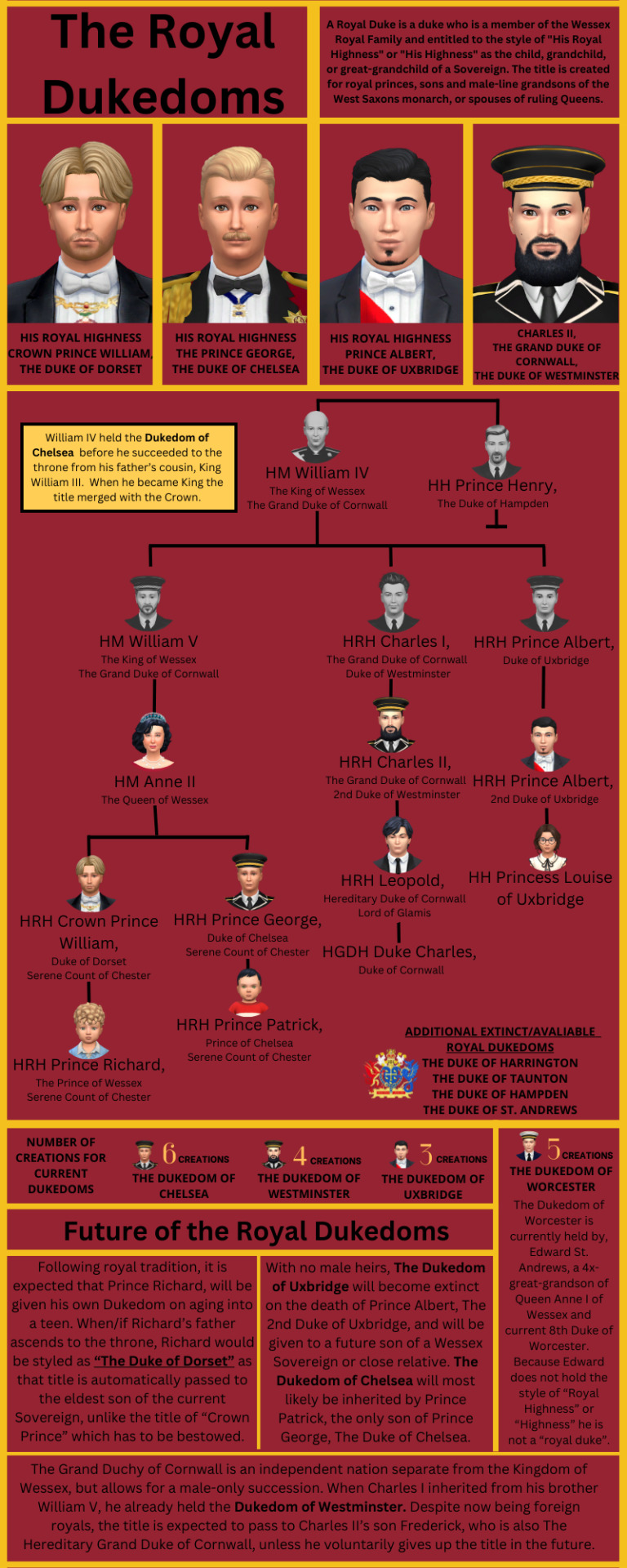

Royal Dukedoms are given to a member of the Wessex Royal Family and entitled to the style of "His Royal Highness" or "His Highness" as the child, grandchild, or great-grandchild of a Sovereign. Royal Dukedoms are the highest titles in the peerage [1]of Wessex.
They are titles created for royal princes, sons and male-line grandsons of the West Saxons monarch, or spouses of ruling Queens. The titles can be inherited but cease to be 'royal' once they pass beyond the great-grandsons of a monarch, as with the Dukedom of Worcester
There has been only one case in which a dukedom was bestowed onto a female member of the the royal family, but the practice has not been done since.
Current Royal Dukes:
HRH The Crown Prince William of Wessex, The Duke of Dorset
HRH The Prince George of Wessex, The Duke of Chelsea
HRH Charles II, The Grand Duke of Cornwall, The Duke of Westminster
HRH Prince Albert, The Duke of Uxbridge

Succession to the Crown Chart | Princess Royal Chart | Counsellors of the State | The Royal Dukedoms | The Earl of Gloucester |
#sims 4 royal simblr#sims 4 royal family#sims 4 royal#sims royal family#sims royalty#sims 4 royals#sims royal story#wessexcharts
15 notes
·
View notes
Text
Recently I have been occupying my time with reading about all things medieval and came upon this from the Chester Herald of Arms:
At the entrance to the churchyard, King Edward waited, together with the Duke of Clarence, the Marquis of Dorset, Earl Rivers, Lord Hastings and other noblemen. Upon its arrival the King ‘made obeisance to the body right humbly and put his hand on the body and kissed it, crying all the time.’ The procession moved into the church where two hearses were waiting, one in the choir for the body of the Duke and one in the Lady Chapel for that of the Earl of Rutland, and after the King had retired to his ‘closet’ and the princes and officers of arms had stationed themselves around the hearses, masses were sung and the King’s chamberlain offered for him seven pieces of cloth of gold ‘which were laid in a cross on the body.’ The next day three masses were sung, the Bishop of Lincoln preached a ‘very noble sermon’ and offerings were made by the Duke of Gloucester and other lords, of ‘The Duke of York’s coat of arms, of his shield, his sword, his helmet and his coursers on which rode Lord Ferrers in full armour, holding in his hand an axe reversed.
This got me so emotional. This is talking about Edward IV at the reburial of his father and brother who were killed in the Battle of Wakefield. From all the sources, I think Richard Duke of York was an attentive father to his elder children and this just seems to be another piece of evidence. Edward truly loved him and that just warms and breaks my heart. This with the letters he sent to his father, my love for this family just grows.
25 notes
·
View notes
Text

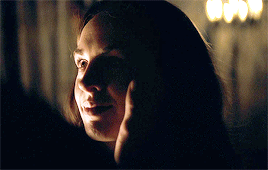
𝗄𝖺𝗍𝗁𝖺𝗋𝗂𝗇𝖾 𝖻𝗋𝖺𝗇𝖽𝗈𝗇-𝗀𝗋𝖾𝗒, 𝖽𝗈𝗐𝖺𝗀𝖾𝗋 𝖽𝗎𝖼𝗁𝖾𝗌𝗌 𝗈𝖿 𝗌𝗎𝖿𝖿𝗈𝗅𝗄, 𝖿𝗈𝗋 𝖻𝗅𝗈𝗈𝖽𝗒 𝖽𝖺𝗒𝗌.
– Born Katharine Brandon on 16 July 1514 at Hatfield House in Hertfordshire, England, to Charles Brandon Duke of Suffolk and his wife Mary Tudor, Queen of France (their marriage, having incurred a steep royal fine and nearly cost them their lives, was by now forgiven and widely admired throughout England). She is christened in robes sent to the Dowager Queen by King Francis I of France (which she will, many years later, christen each of her own daughters in). The second eldest of three, Katharine’s two full-brothers, Henry Brandon (1516-1522) and Henry Brandon Earl of Lincoln (1523-1534), both named in honour of their maternal uncle Henry VIII, tragically predecease her.
– Inheriting the red-gold hair (which darkens with time) and famous beauty of her mother, Mary Tudor, Katharine’s blood pumps with the characteristic hubris of her Tudor relatives. She is raised under her mother’s supervision and, along with her half-sisters Anne and Mary Brandon, blossomed under the tutelage of her nurse, Anne Kynge, at Westhorpe Hall in Suffolk, England. Her father and uncle are always distant, looming figures – great men to be prayed for, but rare to behold with one’s own eyes. In her later years, howbeit, both will be subject to Katharine’s scathing indignity.
– As the niece of the King of England, a swarm of marriage proposals buzzed about Katharine Brandon, suspiciously early into her childhood. One such involving Henry Howard, the Earl of Surrey, was mooted when Katharine freshly sprouted from the nursery, and scuppered in the same year. Though her ambitious father was a true ‘man on the make’ – that is, unscrupulous and grasping – her mother was a natural born princess, and rightly put her foot down when another avaricious offer came Katharine’s way: remembering well the strict warnings of her own grandmother, Margaret Beaufort, against the dwindling institution of child brides.
– But at the age of twelve, Katharine was at last betrothed to Henry Grey, Marquess of Dorset. In 1533, with her uncle king Henry’s hearty blessing, Katharine married Henry at Suffolk Place, her father’s recently built mansion in Southwark. Her mother, by now seriously ill and aggrieved by Charles’ string of lewd mistresses, thenceforth permanently retired from court and settled in ailing discomfort at Westhorpe Hall, where she died on June 25 1533; the Suffolk’s young ward, Catherine Willoughby, led Mary’s elaborate funeral processions. Heartbroken, but as keen-eyed as her father before her, her mother’s death paved the way for Katharine’s career at the royal court, where she assumed Mary’s role in ceremonial affairs.
– Three months after her mother’s death, her father Charles took Catherine Willoughby, then betrothed to Charles’ ten-year old son Henry, as his wife. Whilst also personally interested in Catherine, thirty-five years his junior, Catherine’s hand in marriage effectively made Charles Brandon the richest magnate in Lincolnshire. He then built a series of imposing manors throughout his new lands, gleaned from his fourth, and so far most lucrative, marriage. Katharine railed at her father for his indiscretions, and father and daughter, between 1533 until his death in 1545, spoke less than a handful of times; it is rumoured, and will be confirmed by a letter discovered in 2023, that Katharine never allowed Charles to meet his granddaughters.
– As the niece of King Henry, Katharine was one of the highest-ranking women at court and often took on public duties, lauded for her dignified air (though to some, her insistence on speaking French, lest anyone forget that her mother was once the Queen of France, proved a great irritant). Together with her royal cousins who were near to her in age, Princess Mary and Lady Margaret Douglas, she firmly supported Queen Catherine’s plight in the King’s Great Matter and stood as one of the Queen’s chief mourners upon her death in 1536. Briefly after Anne Boleyn’s coronation, Katharine retired from court to Bradgate House, where she gave birth to her three daughters and soon after returned to the King’s royal fold, taunting her uncle’s new wife, Anne Boleyn, with the string of healthy babes she’d produced in swift succession, and the outwardly ‘happy’ marriage she’d secured. But her union would soon spell trouble that not even Katharine’s ingrained opportunism could surmount, and for all her unbridled boasting, Katharine's private life was all smoke and mirrors.
– Katharine’s inability to bear her husband, Henry, an heir had permanently soured their union; in the end, it was a sin for which Henry could never forgive her. Unbeknownst to him, Katharine did give birth to a son – also named Henry – a stillborn, premature child, in the darkened halls of Bradgate House; it was her eldest daughter, Philippa, who found her mother in a pool of her own blood and shrieked for help. Katharine exhorted Philippa to secrecy and quickly covered up the scene as if nothing had ever happened; neither her husband, other daughters, nor horde of servants ever learned of the tragedy.
– After the death of both Katharine’s father and eldest brother in 1545, Henry and Katharine Grey inherited Charles Brandon’s title of Duke of Suffolk (Henry enjoyed the luxury ‘jure uxoris,’ by right of his wife, though their marriage was, for all intents and purposes, over). Well-aware of the roles her children could now perform in England, Katharine had each daughter remarkably educated (although this did not inhibit them from making inane decisions, evidently…) and employed John Alymer, later Bishop of England, to inoculate their fine, fresh minds with Hebrew, Greek, and Latin, and kept personally abreast of the marriage market of England, resolving that her daughters should have the very best husbands in all of Europe.
– As her husband, Henry Grey, lay dying, Katharine vowed to him that she would protect and advance their family, a promise that her daughters’ reckless incaution has made difficult to keep. As of the start of Bloody Days, Katherine has recently returned from a pleasure trip to France; she returns in grand flourish, keen to reunite with members of her cousin Queen Mary’s court and to continue promoting her daughters (and dotin’ on her secret grandson, Baby Jack). As for this whole 'true Queen' business, well, more of that remains to be revealed :^)
4 notes
·
View notes